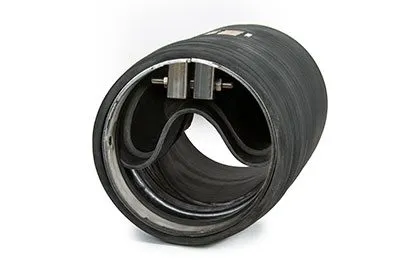What is a Low Headloss In-Line Rubber Duckbill Check Valve?
Authors: Cal Hayes, General Manager – Waterworks Division and Mike Lassas, Vice President – Administration

Low headloss in-line rubber check valves are a very specific type of check valve that many municipal design engineers are specifying across residential and commercial areas of the United States. So what is it and how is it used in municipal pumping applications? Let’s break it down…
Low Headloss – Headloss is essentially the amount of energy which is lost as a result of resistance to flow. A certain amount of energy is required to move a given volume of liquid through a pipe, and as that liquid moves through the pipe, friction causes the resistance to flow and subsequent loss of energy. Low headloss check valves are designed to exhibit low headloss characteristics (or low loss of energy) during operation, which is important for municipal design engineers to know as these valve headloss values affect pump selection. A design engineer has to know how much headloss is estimated to occur as the liquid moves through the check valve in order to select the right pump to push fluid through that piping system.
In-Line – An “in-line” style check valve is usually installed at the inlet or discharge end of a piping system. Typically, when you install an in-line check valve in a piping system, 40% to 60% of the flow is constricted (if you have a 6-inch line, for example, flow is only moving through 3 or 4 inches); so in some cases, municipal design engineers may need their in-line check valves to have a full port design.
Rubber Duckbill – Rubber duckbill check valves have been around since the 1980s and are well known in the U.S. as they were designed to replace traditional swing gate or flap gate type check valves. Ideal for water and wastewater systems, rubber duckbill check valves are elastomeric, and therefore, have the capacity to flex around objects that might get caught up in the water and wastewater stream, such as beer bottles and other kinds of debris. Rubber duckbill check valves, which are less likely to freeze or deform, are designed to withstand most types of municipally pumped media.
Check Valve – A check valve is installed in a pumping system to prevent the backward flow of the pumped material or to prevent backflow from outfall discharge areas. There are many types of check valves, and different ones are used in various types of municipal applications. Commonly used to control back pressures from sewage plants, outfalls and tidal operations, in-line rubber duckbill check valves are fully passive flow devices which do not require maintenance or any outside sources of power or manual assistance to operate.
Putting it All Together to Meet the Need
There are some municipal applications that require ZERO backflow – applications where are low headloss in-line rubber duckbill check valve is the most ideal solution. The applications include Combined Sewer Overflows (CSOs), Sanitary Sewer Overflows and storm water outfalls.
Combined Sewer Overflows (CSOs):
A combined sewer is a sewage collection system of pipe and tunnels designed to also collect surface runoff. Combined sewers can cause serious water pollution problems during combined sewer overflow (CSO) events when wet weather flows exceed the sewage treatment plant capacity.
Sanitary Sewer Overflow:
A condition in which untreated sewage is discharged from a sanitary sewer into the environment prior to reaching sewage treatment facilities.
Outfalls:
An outfall is the discharge point of a wastes stream into a body of water; alternatively, it may be the outlet of a river, drain or sewer where it discharges into a body of water.
If you want to learn more about low headloss in-line rubber check valves, check out the ProFlex Style 790 Low Headloss In-Line Rubber Check Valve which was recently flow tested at the Utah Water Research Laboratory in June 2017. You may also contact Mike Lassas or Cal Hayes to learn more or to request flow data (which is now available for sizes up to 96 inches).

Flow testing of the Style 790 Low Headloss In-Line Rubber Check Valve at the Utah Water Research Laboratory in June 2017







